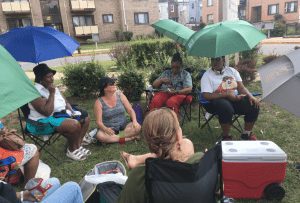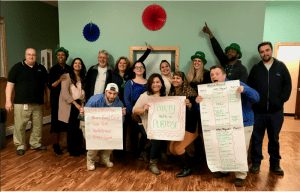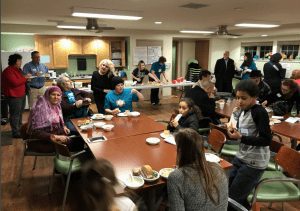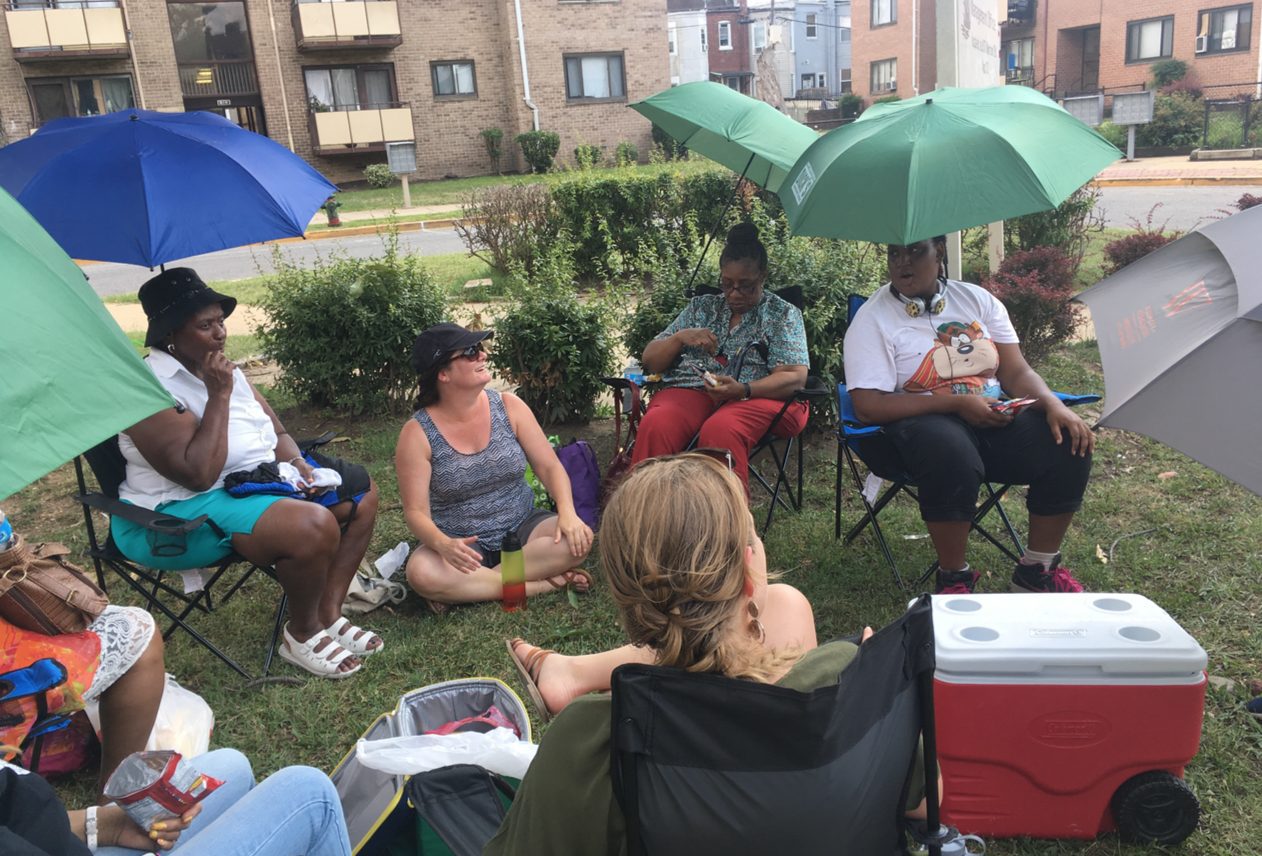
Photo courtesy of Trusted Space Partners
In a recent article, Derek Hyra reflected on the challenge of micro-segregation in mixed-income communities specifically built and funded to provide greater mixing of people of different socio-economic backgrounds. (Hyra defines micro segregation in this way: “In some newly created mixed-income, mixed-race communities, we are witnessing “diversity segregation,” where people of different backgrounds, races, ethnicities, and incomes live next to one another but not alongside one another.”)
He questions whether these diverse communities are designed to sufficiently facilitate social interactions that benefit low-income residents. Among other ideas, he suggests the creation of new third spaces and community organizations that are welcoming and empowering to these residents.
As longtime community builders who have been working almost exclusively for the last six years in a variety of housing communities, both mixed income and 100 percent affordable, we welcome Hyra’s article and seek to build upon it with some of the lessons we are learning.
Much of our recent work has been in partnership with the National Initiative on Mixed Income Communities with both the HOPE SF public housing transformation initiative in San Francisco and the New Communities Initiative in Washington, D.C. We also currently work with two leading private housing development/management companies and several large nonprofit housing developers in multiple regions around the country.
It is important for us to note up front that we, like many others, remain skeptical of the promise of mixed-income communities to achieve much of what community development and affordable housing professionals, among others, are relying on it to achieve. We feel there are baked-in racial and class assumptions to this approach that need to be stated and challenged at every turn. There are also competing interests among those who advocate for, invest in, build, manage, and live in these places. However aspirational, and perhaps even achievable the goal of genuine and equitable mixing, it is not the only or most important goal of the major players involved.
That said, we do believe that healthy communities need to strive to create spaces for genuine mixing and exchange across lines of difference. At a time in our country that some are calling a new era of segregation, there are precious few opportunities to bring resources, intentionality, and planning to this work. For that reason we have immersed ourselves in some dynamic initiatives across the country, working alongside others who are taking bold steps to make this happen in their communities. And we have learned some lessons.
Our first lesson to offer is how important it is to accurately frame the challenge of mixed-income communities. After years of trial and error, we begin our work from this question: How can we—the owners, managers, partners, and residents of this housing community—work together to shift the underlying operating culture of isolation, fear, and anger to one of aspiration, connection, and collaborative action?
We believe this question provides three important building blocks for creating the kinds of trusted space needed to achieve mutually supportive relationships across big societal divides.
-
A Truthful Narrative
This question helps everyone begin this intentional journey of mixing, exchanging, and acting together with a more truthful narrative about the development of the community and/or the stories each person brings with them about “the other.” Most intentionally mixed-income housing developments have replaced a public or subsidized housing community that suffered through long years of public neglect and disinvestment. Many of those residents—despite deplorable conditions and sporadic anti-poverty programming—forged relationships and a way of life that has since been blown up, all with the promise of mixed-income housing as the grand solution to years and years of systemic racism and oppression. The baseline assumption that many residents are making is that this is another form of brown and Black people removal, and with good cause.
Even when this kind of history is not present, we know from the research on unconscious bias that ALL residents and staff bring established assumptions about one another and feelings that are triggered even before we hold an initial conversation.
Moreover, the sheer trauma of yet another externally orchestrated uprooting for vulnerable families is a powerful and omnipresent factor. It is a rare situation where the unspoken “air” in a mixed-income community is not filled with feelings of anxiety, fear, defensiveness, and anger.
-
The Interdependence of Every Human Being
The question also makes it clear that everyone who works and lives in a housing community is a human being interdependent on other human beings for the creation of a high quality of life for everyone who lives there.
It is very easy (and really the norm) to forget our shared humanity in these overly structured and regulated housing communities. The complex interplay of public and private entities, along with the societal history of landlord power over tenants, creates distinct role identities and huge divides on both the resident and staff sides. (And this is before you add in a programmatic decision to intentionally bring together people who have very different incomes and socio-economic backgrounds.)
People who are motivated to build relationships can bridge the myriad of divides and find a shared path forward. Institutional players with entrenched and narrow interests cannot, and will not. It is no wonder that many early examples of mixed-income housing resulted in harmful micro-segregation rather than beneficial income mixing.
We agree with Hyra that one critical ingredient toward successful mixing of people across deep income divides is to create spaces and small groups where long-term, lower-income residents can experience greater self-agency and shared power. However, the challenge with a strategy focused only on the lower-income residents is that it presumes that the middle- to upper-income residents, as well as the professional housing managers, would not benefit from their relationships with people of lower income and do not need to go through a “self-growth” process to learn how to share their greater positional power with others. We believe everyone in these environments has a lot of learning and growing to do and can experience tremendous personal gain from new relationships and experiences.
-
An Honest and Compelling Invitation
The question provides an honest and compelling invitation to everyone involved: Please bring your best self and let’s work together on something we can control and influence: the operating culture of the place where we live and work. As neighbors and co-workers, we may not know how to create a new jobs program or how to re-engineer the public schools, but we can create an environment where the talents of every person are celebrated and valued, in both individual pursuits (improving health; learning a new language, managing a moment of transition) and collective pursuits (hosting community events, supporting young people, ensuring safe neighborhood conditions). When we can make progress on these smaller quests, we develop greater trust and capacity to envision shared solutions to larger, more systemic questions of equity, inclusion, and quality of life for all. This is the stuff of “neighboring” that is, in turn, the landscape of connection and quality of life in any healthy community.

Photo courtesy of Trusted Space Partners.
One open question among mixed-income housing practitioners is whether to be explicit during the marketing phase about the mission of mixing across lines of difference. We vote for being clear about the exciting challenge available to the potential resident, and believe such disclosures will create more favorable conditions for engaging people in the hard work of mixing and shifting the underlying operating culture, once they make a well-informed decision to move in.
Another big lesson we brought with us into the mixed-income housing environment is that of intentionality. We have found that even with the above building blocks, it is nearly impossible to convince a mixed group of folks to come together to build relationships and trust without an intentional invitation process, and creating intentional spaces with intentional practices for connection and conversation.
The word “intentional” means that we, as community builders, are thoughtful and proactive in disrupting the negative assumptions and fears around connecting with neighbors (especially when the neighbors are a diverse group), which includes creating an experience that is fun and produces immediate value, increasing the chance that a person will accept our invitation and show up the next time. This intentionality is not costly, but it does take a diverse team working over an extended period of time with skill, self-awareness, commitment, and creativity.
Recently, we were working in a mixed-income neighborhood that included longtime public housing residents and new young professionals. Our short-term goal was to host a monthly gathering to begin the relationship building and collaborative action process. We knew that a set of flyers, door knocks, texts, and social media posts would not produce the kind of room we were trying to create. We first went on a listening campaign, talking to as many folks as we could about the neighborhood and their lives. We then committed time to designing a message and invitation that related to what we were hearing (and wove in the other building blocks discussed above) and practiced delivering it on each other.
As a final step, we created pop up “moments” that allowed us to disrupt a central location in the neighborhood and invite people to hang out for enough time to begin the invitation process and get contact information for follow up calls and door knocks. One pop up spot was an island of grass next to the public housing mailboxes, and another was in the fancy new coffee shop around the corner, both of which produced a set of beginning relationships from each socio-economic group upon which to build.
As we connected with people and formed initial relationships, we invited them to a gathering in the neighborhood. We are quick to say that this gathering was not a typical community meeting, but instead was more like a “party with a purpose”. We asked for their phone number and promised to call and remind them of the gathering. (We’d often knock on their door and call them twice—one week before and again one day before). Our goal was 40 people at each monthly gathering with a mix of demographics. To achieve that we figured we needed to connect with and be actively calling 80 people from each of the two groups.
This is when the focus on intentional space and intentional practices kicks in. We know that from the very first moment that a person is brave enough to walk into a new community space, they need to feel welcomed, safe, and assured that our promise of a party with a purpose is not a trap for a typical community meeting where a few people with positional power talk at others and dominate the use of time.
After hosting hundreds of these non-traditional gatherings, we have homed in on three key ingredients for success:
- A quality room with decorations, music, good food, chairs in a circle, bright explanatory posters, fun decorations and easy ways to connect with others over dinner.
- Welcoming and diverse stewards from the neighborhood who serve as hosts and facilitators.
- A 90-minute format that unfolds the same way each time without exceptions, with three ritualized activities designed explicitly around building and strengthening personal relationships:
- sharing something new and good in their lives;
- relevant small group conversations hosted by participants on topics suggested on the spot, and;
- neighbor-to-neighbor exchanges of favors.
There is no pre-set agenda or scheduled speakers, and everyone who attends, including elected officials and corporate leaders, participates on equal ground. No one is forced to do anything and everyone has multiple opportunities for participation and expression.

Photo courtesy of Trusted Space Partners
The most important ingredient in this “party with a purpose” are the three ritualized activities, and the fact that anyone can facilitate these rituals once they have experienced them a couple of times. The first ritual, which we call “new and good” simply invites everyone in the room to share something new or good in their personal life. The objective is to get everyone’s voice in the room right away, pump positive energy into the room, and give everyone an opportunity to provide a glimpse of ourselves as human beings. The second ritual, which we refer to as “table talks” or “the business of the network” provides a creative and backdoor way for productive power sharing on both personal and common topics.
In one large complex of 900 units, residents repeatedly hosted a table talk about their concerns with the manager’s security company. At first, the security guards (who attended the gathering as human beings) were a little defensive and on edge. But, after the third small group conversation on the same topic, relationships had begun to form and a series of solutions were crafted in the brief 20 minutes allotted to table talks. In another community, a resident expressed her interest in starting a small community swap initiative, and a neighbor who owned and ran a local consignment store sat with her and others, and offered advice and follow up support during their 20-minute table talk.
Our favorite ritual is the last one of three and we refer to it as the marketplace. Everyone comes back together after the smaller table talks and stands in a large circle. In 30 seconds or less, each person can make a request or offer for something they need or a resource or talent they have. The list of amazing resources exchanged is long and varied, but some examples of neighbor to neighbor matches include rides to grocery stores, gently used children clothing, healthy recipes, meeting of walking partners, help with computers, job leads, birthday party ideas, etc. Uncovering resources in an apartment complex or neighborhood is the best part of the journey for us, and the magic of this ritual is that most people leave the “party with a purpose” with something of value or feeling valued, and this is what encourages them to come back, time and time again.
There are two big questions we cannot answer in this article, though we are in the middle of a continued, long-term experimentation process to address them. One is, which institutional entity, among the many involved in a typical mixed-income housing development, is the best to host the kind of skilled community building team needed to facilitate these interactions. For the moment, we are landing on the critical role of property managers, and are finding the most momentum when we can work with a committed, innovative property management staff. They exist, but can be hard to find.
The other big question is how does a mixed-income housing community sustain relationship building and collaborative action over time—beyond the initial success of a campaign, during which these new practices and spaces are introduced?
We do know that formation of a resident council, especially one that re-introduces hierarchical forms and practices into a newly integrated environment, is absolutely not the answer. We have had success in larger neighborhood settings with the formation of an intentional network, one that has a rotating team of diverse stewards charged only with the cultivation and well-being of the network and not in charge of making community-wide decisions. (To learn more about neighborhood networks, check out these thriving ones: Impact Silver Spring in Silver Spring, Maryland; Lawrence Community Works in Lawrence, Massachusetts; Neighbor Up in Cleveland, Ohio; Bedford Connect in Pittsburgh, Pennsylvania; Pittsfield Working Cities in Pittsfield, Massachusetts; and Union Capital Boston in Boston.)
Our hunch is that a similar strategy works in a housing community.
We welcome continued dialogue and exchange around these and many other questions facing the future success of the many mixed income housing communities cropping up across our country.






Comments